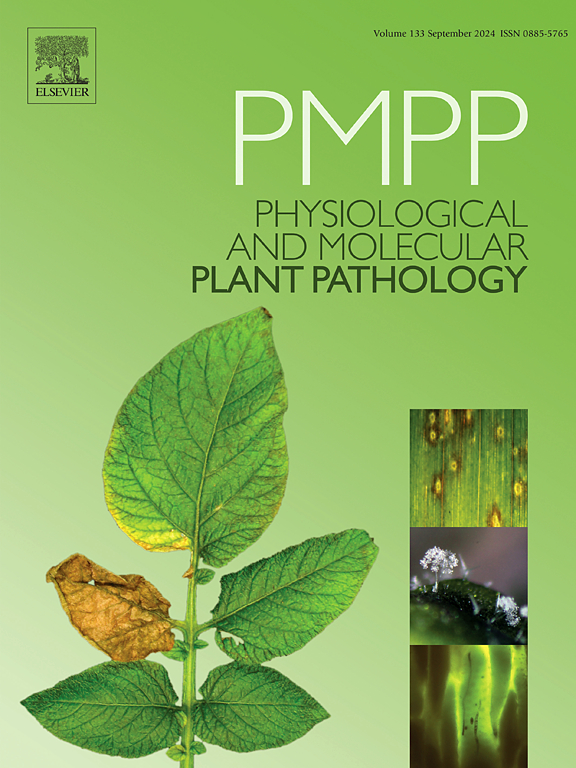基因系谱揭示了印度西北部棉花根腐病病菌(Macrophomina phaseolina (Tassi) Goid)最近的种群扩张
IF 2.8
3区 农林科学
Q2 PLANT SCIENCES
引用次数: 0
摘要
棉花根腐病是棉花最具破坏性的真菌病害之一。本研究标志着印度西北棉花带油菜分枝杆菌全面群体遗传分析的开始,包括从印度四个邦(哈里亚纳邦、旁遮普邦、拉贾斯坦邦和古吉拉特邦)收集的55个地理上不同的病原菌分离株。对分离株进行ITS和EF-1α区测序。所有4个菜豆种群均表现出单倍型和核苷酸多样性模式,表明在种群快速扩张之后存在历史瓶颈,即高单倍型多样性(0.714)和低核苷酸多样性(0.0025)。在中间连接网络中观察到的星形结构也支持了在恒定种群规模的背景下偏离中性的假设,从而提供了种群扩张的证据。从低水平的遗传分化可以看出,不同地理位置的菜籽草居群似乎在很大程度上形成了一个泛群或结构弱的元居群,而不是被强烈细分。中性试验结果表明,菜豆绿僵菌与中性有显著偏差,田岛的D、Fu和Li的D∗和F∗值均为负,表明近期正选择或种群扩张。错配分布分析进一步支持了近期人口扩张。分层AMOVA分析的结果表明,不同居群之间缺乏明确的遗传界限,与居群内差异相比,居群之间的变异百分比较低。本文章由计算机程序翻译,如有差异,请以英文原文为准。
Gene genealogies reveal recent population expansion of cotton root rot incitant, Macrophomina phaseolina (Tassi) Goid in North-Western India
Cotton root rot, incited by Macrophomina phaseolina is one of the most devastating fungal disease of the crop. The present study marks the inception of comprehensive population genetic analysis of M. phaseolina across the North Western cotton belt of India, encompassing 55 geographically distinct isolates of the pathogen collected from four states of India: Haryana, Punjab, Rajasthan, and Gujarat. The isolates were subjected to ITS and EF-1α region sequencing. All four M. phaseolina populations display haplotype and nucleotide diversity patterns indicative of historical bottlenecks followed by rapid population expansion, as evidenced by high haplotype diversity (0.714) coupled with low nucleotide diversity (0.0025). The star-like structure observed in the median-joining network also support the assumption of a departure from neutrality in the context of a constant population size, hence providing an evidence of population expansion. M. phaseolina populations in different geographical locations appear to form a largely panmictic or weakly structured metapopulation rather than being strongly subdivided as evident from low levels of genetic differentiation. Neutrality tests on M. phaseolina showed significant deviations from neutrality, with strongly negative Tajima's D, Fu and Li's D∗, and F∗ values, indicating recent positive selection or population expansion. Mismatch distribution analysis further supported a recent demographic expansion in the population. The results of hierarchical AMOVA analysis implied a lack of clear genetic boundaries between different populations of M. phaseolina, as supported by the low percentage of variation between populations compared to within-population differences.
求助全文
通过发布文献求助,成功后即可免费获取论文全文。
去求助
来源期刊
CiteScore
4.30
自引率
7.40%
发文量
130
审稿时长
38 days
期刊介绍:
Physiological and Molecular Plant Pathology provides an International forum for original research papers, reviews, and commentaries on all aspects of the molecular biology, biochemistry, physiology, histology and cytology, genetics and evolution of plant-microbe interactions.
Papers on all kinds of infective pathogen, including viruses, prokaryotes, fungi, and nematodes, as well as mutualistic organisms such as Rhizobium and mycorrhyzal fungi, are acceptable as long as they have a bearing on the interaction between pathogen and plant.

 求助内容:
求助内容: 应助结果提醒方式:
应助结果提醒方式:


